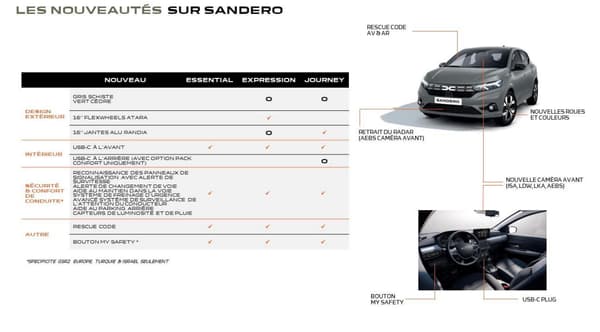New cars, increasingly more expensive, have been a reality for many years. The reason, in particular, is the tightening of anti-pollution regulations, but also of safety regulations. Concrete example in a few months, with the obligation that all new cars sold in the European Union have new equipment.
Audible and visual alerts in case of excess speed
A regulation known as GSR2 (for “General Security Regulation 2”) which involves, in particular, the implementation of an ISA (“Intelligent speed assist“) or AIV in French, an intelligent speed adaptation system. Its function: warn the driver when the limit is exceeded through an audible and visual alert, encouraging compliance with the rules and thus reducing the number of accidents and their severity.
Therefore, to work, this system must know what the speed is on the road taken. However, several basic range models, especially those from Dacia, did not until now have at least one of the two pieces of equipment necessary for this function: a signal recognition camera and a GPS.
Contacted by BFM Business, the Renault group brand informed us that its models would comply with the new legislation, with the generalization of “traffic sign recognition with excessive speed warning”, the commercial name of the AIV chosen by Dacia.
A couple of GPS cameras to control speed
“The camera will allow us to operate various safety functions such as the AEBS (“Advanced Emergency Braking System”, automatic emergency braking) capable of reacting to avoid hitting a vehicle, a cyclist or a pedestrian in association with the radars, but also the recognition of limitation signals”, explains Jean-Louis Martins, director of transversal operations at Dacia.
This system will be combined with a GPS chip, even in models that do not have navigation as an option. Therefore, there is no standard mapping, but rather the vehicle’s ability to constantly know where it is and the current limitation.
The camera will allow you to better adapt to certain situations, such as specific limitations related to work or specific limitations for certain users.
“The operation of the windshield wipers will also allow you to adjust the limit, which on French motorways goes, for example, from 130 to 110 km/h in the event of rain,” adds Jean-Louis Martins.
A button to disable startup alerts
If the application of this speeding alert raised fears of a period of direct action by the vehicle to brake the vehicle, the European text does not actually impose it. Only visual or audible alert is imposed.
This will be the case with Dacia, which specifies that, if a regulator or limiter is activated, the vehicle will simply suggest the driver reduce the setpoint if it detects a new limitation: a recommendation that must be validated directly while driving. “But it will not be forced,” insists Jean-Louis Martins.
If the beeps already promise to annoy many drivers, most brands that already have this type of alerts usually have a relatively simple way to deactivate them, with a few clicks on the screen for example. European regulations do not prohibit it, but simply require the return of “default” alerts at each start.
At Dacia we have also anticipated this problem by adding a physical “My Safety” button, which will therefore also work on models without a standard touch screen, such as a Sandero in Essential finish. One press will allow you to find your personal settings, such as no beeps or visual alert in case of overspeed.

No significant additional costs expected
This new regulation will also add other standard functions such as lane change warning and lane keeping assistance or even a “driver attention monitoring system.”
A sensor on the steering wheel will be able to detect suspicious movements. Also taking into account the duration of the trip and the speed, an algorithm will determine the risk of fatigue and display an icon of a coffee cup inviting the driver to take a break.
The next step will be in 2026, with the obligation to control the driver’s attention using a camera that will film their face. Equipment that is already offered on some models and that can attract attention if you do not look closely at the road, but that are not immediately found in Dacia.
“Dacia’s philosophy is to offer safety systems to our customers from the moment the cost is controlled: today, the blind spot warning is not mandatory if we look at the legislation, but we offer it in several of our models “, emphasizes Jean-Luis Martín.
Meanwhile, the new mandatory equipment will appear on the Sandero, its Stepway version and the Jogger, for orders from April.
If Dacia has not yet communicated the new prices, we should not expect too many additional costs, assures the brand, which wants to maintain its affordable positioning.
“The camera will replace, in particular, part of the radars that were already used for automatic emergency braking,” says Jean-Louis Martins.
Currently, the Sandero remains the cheapest new car on the French market with a price starting at 11,990 euros.
Source: BFM TV


